Salsa in Singapore: “the vertical sex dance”!
In April 2012, we had the chance visiting Singapore for about 10 days. In this article we would like to share our experience about Singapore and the Salsa scene in Singapore.
First about our experience in Singapore
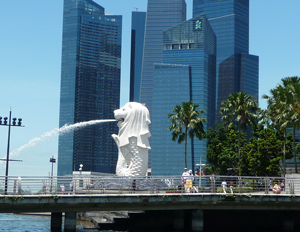 The image many people (we know in the USA) have about Singapore is that it is very clean there and – thanks to US media’s scares – that you must under no circumstance chew gum (or was it littering gum on the street?). Salsa dancing is not something people associate with Singapore. So, how come we went to Singapore exploring the Salsa scene there?
The image many people (we know in the USA) have about Singapore is that it is very clean there and – thanks to US media’s scares – that you must under no circumstance chew gum (or was it littering gum on the street?). Salsa dancing is not something people associate with Singapore. So, how come we went to Singapore exploring the Salsa scene there?
Well, thanks to Chris’ day-job we had this rare opportunity adding Singapore to our list of countries where we explored Salsa and “Rueda” as it is called here. In order to excel our skills as dancers and teachers, it has become an obsession to connect with the teachers of any places we visit around the world.
Some of the places where we explored the Salsa and Rueda (Rueda de Casino) scene outside the USA were among our trips to Cuba, Moscow, Shanghai, Tokyo, Mexico, and many cities in Germany. Of all these places Singapore was probably the most diverse country we have ever visited – without chewing any gum during our entire stay, of course.
The first impression at the Changi airport confirms that it is clean, modern and quite technological advanced. When we stepped out of the airport to get a taxi, the hot and humid air hit us. During our stay we had temperatures of 80 to 95F with a humidity of 80-95%. Life without air conditioner would be unthinkable. What did people do before that?
This is an incredible country. A melting pot of multicultural diversity, ethnicity and religion. And they all seem to get along very well; at least what we observed.
Singapore is an island – growing artificially in land mass – with about 4-5 million people plus about 2 million people coming from neighboring countries and working there. The majority of people are of Chinese ethnicity with about 70% followed by Indian. We hear people saying that Singapore has 100% employment and is short on educated and trained labor.
Some things are quite expensive here. Beer and wine go for Singapore Dollars (SGD) 15 to 25 per glass (about 12-20 US $) in bars and restaurants and we bought a bottle of wine at the nearby 7-Eleven for SGD 40 (about US$32). Food stands and restaurants are on every corner.
Yes, it was hot and humid. It is hard to escape the outside as a tourist when you want to explore some of the sights. Sometimes the hot sun is interrupted by heavy thunder storms as it did when we arrived in Singapore at one in the morning.
As a tourist walking in Singapore city and using the MRT (Metro Rail Transportation), it is hard to identify which ethnicity dominates. Although white people stand out clearly, you cannot say if someone is from neighboring Malaysia, China, India, Philippines, Thailand or Indonesia. We see many religions such Christianity, Hinduism, Islam and Buddhism. Everybody seems to get along with peace and respect.
It is crowded and you would think that some tension or aggression would surface. However the opposite seems to be the case. In the metro you can see billboards promoting respect to each other, be polite, offer your seat to others. In fact there is the Singapore Kindness Movement, a non-profit organization located at the Ministry of Information, Communication and the Arts.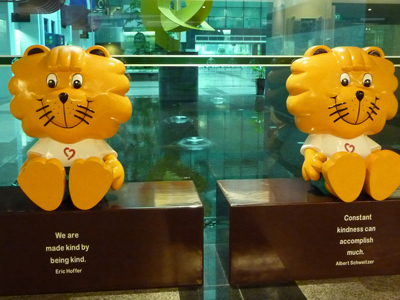
There are cameras everywhere; in every corner at least 3-6 of them. Not surprising to say that there is no graffiti here. We did not see anyone chewing gum. In the Metro high fees starting at SGD 300 (US$240) repell anyone from eating or drinking in the Metro. This is enforced by regular announcements from speakers. We also had not heard police sirens at all and we saw the presence of police maybe twice in the 10 days we stayed here.
Singapore is also known as a Garden City, with planned green space and parks. Our experience was that the entire city consists basically of luxury brand shopping malls and skyscrapers with construction everywhere. Everything is super modern here and super clean and very well organized.
It is easy recognizable that the country is built on its English heritage. If we hear English it’s with a British or Australian accent. Signs in the Metro warn kindly to “give way to alighting passengers”. Chris’s reaction: “alighting.…what?”. English is the main language, although majority of people are from China, then India. Although everyone here is supposed to speak English, it is sometimes very difficult to understand because of the different accents.
There are 7-Eleven stores on every corner, then McDonalds, BurgerKings, Wendy’s, KFC, of course Starbucks; basically all of the known brands from the US are represented here. We did not eat at any of these places (for the record).
Huge walls with commercials in English featuring often white people. The music in the taxi plays Frank Sinatra, Dean Martin or Tom Jones. All of this makes you easily forget that you are far away in another country.
It is hard for us to recognize a clear Singaporean identity. Although Singapore is a young country which gained independence from British rule in 1965, its own identity appears to be diluted among all the other ethnicities around. Maybe the Singapore identity is multicultural.
To escape all of the modern commercialism, we go to Little India or Chinatown. Both are just one or two stops from our Metro station. Leaving the super-clean, super modern and camera covered Metro, we find ourselves in a completely different world. In Little India we eat with the locals and in Chinatown we get our foot massages with the locals for one hour for SGD 20 (US$16) and watched with suspense the popular Chinese soap opera on TV with English subtitles. After a couple of visits people recognized us already and this familiarity makes us feel much more welcome and comfortable.
Salsa in Singapore: “so hot to trot”!
The Salsa scene is quite interesting. While we were there, “thesundaytimes” newspaper happened to run a two page article about it. “Salsa dance classes are promising working professionals a good workout plus a chance to meet their lifelong partners”. “Singaporeans are letting their hair down by taking up Latin dance classes – and finding Mr or Miss Right.” The Latin style is described as “vertical Sex dance”.
Most dance students are single, working professionals in their 20s and 30s.
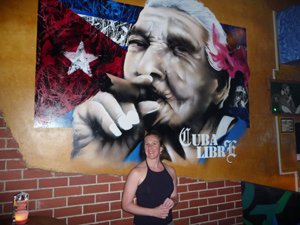 Dancing encourages shy folks to open up, a catalyst to meet friends and socialize, like “speed dating.” Classes cost between SGD $20-25 (US$16-20) per lesson. We did not see any discounts like for students. This is quite a difference compared to our $8 per class and $4 for students. There are about six big dance schools offering Latin dance classes. Dance schools like Dance En Motion, Jitterbug Swingapore and JJ SalsaRengue offer Salsa, ChaChaCha and Bachata. The known schools offering Rueda are Jitterbug Swingapore and JJSalsaRengue.
Dancing encourages shy folks to open up, a catalyst to meet friends and socialize, like “speed dating.” Classes cost between SGD $20-25 (US$16-20) per lesson. We did not see any discounts like for students. This is quite a difference compared to our $8 per class and $4 for students. There are about six big dance schools offering Latin dance classes. Dance schools like Dance En Motion, Jitterbug Swingapore and JJ SalsaRengue offer Salsa, ChaChaCha and Bachata. The known schools offering Rueda are Jitterbug Swingapore and JJSalsaRengue.
There are a few Salsa clubs in Singapore city. The two known clubs we heard of and visited, Cuba Libre and Union Square seem to tailor towards tourists. Union Square was in a mall (like so many things in Singapore) and the entrance under construction (again, very typical for Singapore). Cuba Libre, located at Clarke Quay, a riverfront area where most night clubs cluster, had the smallest dance floor we have ever seen and a four member combo from Colombia. We heard only a few Salsa-like songs playing, and more such as Merengue, Bachata, ChaChaCha, and some Cumbia-based Salsa. So, music with easy beat, sing-along rhymes designed for the non-Salsa dancing enthusiasts after a few drinks. When Chris asked the band leader if he can play some Timba, he said that he does not know how to play that.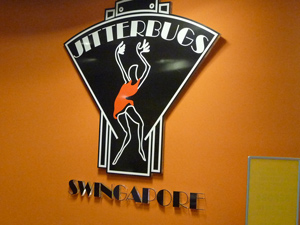
Then during the band’s break, all the DJ music was Regaetton, and Merengue-disco style. That is when most people got up and danced (sort of). Unfortunately, we did not hear any Timba playing at all. According to local dance instructors, popular songs are from Joe Arroyo, Sonora Carruseles and Ray Baretto. Other songs are from artists such as Louis Ramirez, Grupo Gale, Tito Valdes, and Tito Puente.
We connected with the Salsa schools offering Rueda style Salsa: Jitterbugs Swingapore and JJSalsaRengue. The Jitterbugs Swingapore did not have any Salsa Rueda scheduled until June. But we met Jackson and June from JJSalsaRengue – which stands for Salsa Merengue.
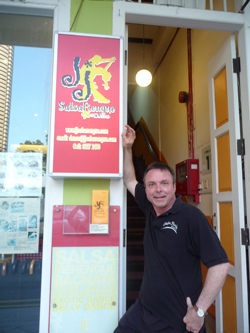 Jackson and June are well famed in Singapore for their Salsa and Salsa Rueda. They began their dance studio in 2001 and became professional in 2004. They are also well-known co-organizers of the Singapore International Salsa Festival. We enjoyed our talks with them and exchanged some experiences.
Jackson and June are well famed in Singapore for their Salsa and Salsa Rueda. They began their dance studio in 2001 and became professional in 2004. They are also well-known co-organizers of the Singapore International Salsa Festival. We enjoyed our talks with them and exchanged some experiences.
They offer “Salsa Casino Rueda” in 4 week series classes from level 1 to 5. However, they require dancers to take 20 hours of “regular” salsa before signing up for Rueda. This is quite in contrast to our Rueda Beginner classes in which many people start to learn to dance Salsa and some even start to learn to dance.
Jackson and June wrote the curriculum of moves on posters on the wall in the dance studio. They are all based on Miami’s vocabulary (Henry Herrera, Billy Fajardo and Ramani Nicola). We noticed some variations and discussed the differences with Jackson.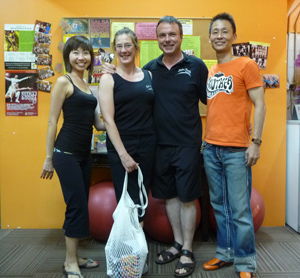
Friday night, they held their monthly social at the studio for SGD 5 (US$ 4) from 10pm to 12:30am. They called quite a few Ruedas. It’s always amazing to find ourselves half way across the world and suddenly dancing to a common vocabulary with strangers. A few of the calls were not easy to understand because of Chinese pronunciation, and some other moves had variations such as La Una (instead of El Uno). Some fun moves like Adios con gitarra, Vacila sentada, and Tarrito de mentira. With each Dame, both followers and leaders made a turn, leaders to the left, to face the new partner.
All the Salsa people knew each other very well. What a nice community they have there. The first leader who asked Jessica to dance asked “Are you Cuban?” because she did not strictly line up in the “slot” style of linear salsa when following. When dancing regular Salsa the dancers we observed were mostly well trained dancers, connected with their followers and having a really good time. They all danced linear Salsa, lining up perpendicular to the mirrored wall. All were young (under 30). After the social dance some went to the nearby Union Square club until 2 am.
We miss Singapore and the exposure to a multicultural society of people peacefully living together encouraged by the kindness movement with observing cameras everywhere which made us a bit concerned. A densely populated city which is modern, clean, still growing in land mass with omnipresent construction zones. The people are friendly here and we miss our routine in Little India and Chinatown. We also miss the Chinese soap opera and wonder how it all ended. More-so we regret that we did not have more time to explore the Salsa dancing scene which is so much larger than we expected. Strange: somehow we forgot all about chewing gum and don’t miss it now.
Chris and Jessica
SalsaGente.com
Santa Cruz, California
This article is based on personal experience and opinion of Chris and Jessica of www.SalsaGente.com made in April 2012.
Copyright 2012 SalsaGente.com